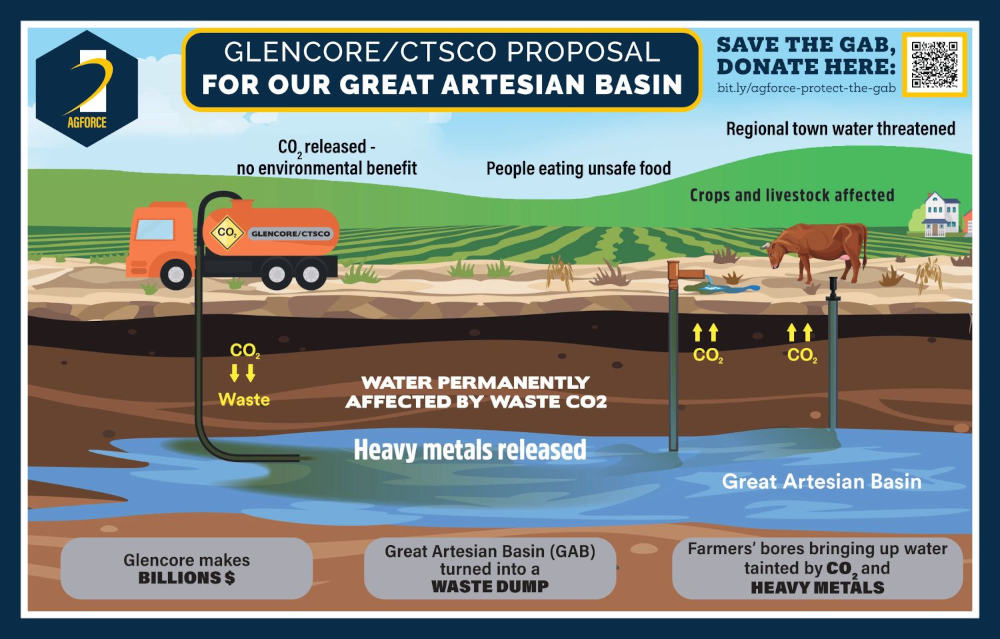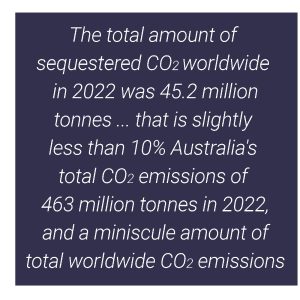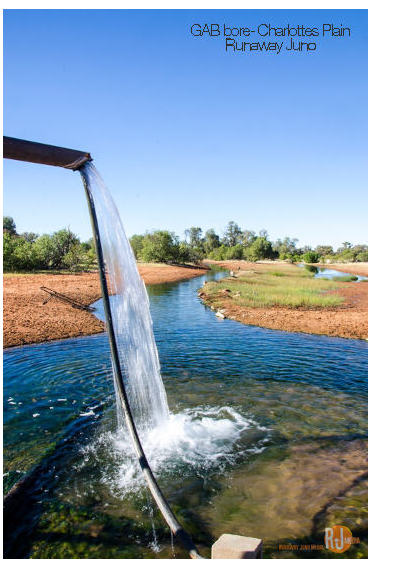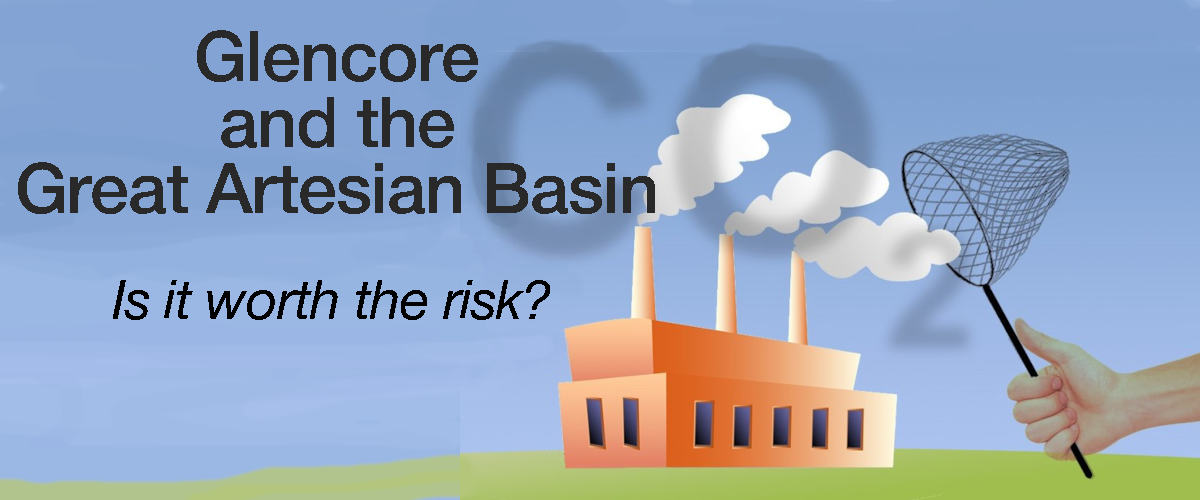INTRODUCTION
INTRODUCTIONTHE GREAT ARTESIAN BASIN is the largest and deepest artesian basin in the world and underlies about 22% of the Australian continent, including most of Queensland, and stretching into the Northern Territory, north-eastern South Australia and northern New South Wales. The basin is up to 3000 metres deep and is estimated to contain 64,900 cubic kilometres of groundwater. The basin provides all the irrigation, stock and most household water for much of inland Queensland and as well as it’s absolutely critical importance to farms, communities and businesses, is worth about $13 billion to the national economy.
THE GLENCORE PROPOSAL. Glencore plc is a Swiss multinational commodity trading and mining company and describes itself on it’s website as one of the world’s largest globally diversified natural resource companies. Glencore is run by, once again, a multinational CEO, Ivan Glasenberg who has held or still holds Australian, Israeli, South African and Swiss nationalities. Glasenberg is the largest individual shareholder of Glencore with about a 10% stake.
Glencore operates 23 mines in New South Wales, Queensland, Western Australia and the Northern Territory, currently mining coal, copper, lead-zinc and nickel-cobalt.
Carbon Transport and Storage Corporation (CTSCo) is a wholly owned subsidiary of Glencore that is currently involved in attempting to develop carbon capture and storage technology in the Surat Basin in Queensland, which is part of the greater Great Artesian Basin. The proposal for which Glencore seeks approval involves capturing and liquefying CO2 from the Millmerran coal-fired power station and then trucking it north to a storage well near the farming town of Moonie, about 400 kilometres west of Brisbane. CTSCo is aiming to inject up to 110,000 tonnes of food-grade CO2 per year into the Precipice Sandstone, a groundwater formation with “brackish water that is unfit for human consumption” about 2,300 metres underground.
The proposal from Glencore has predictably evoked an enormous amount of comment and criticism from a very diverse cross-section of the community. In this essay, some of the main points of contention will be considered with risks and potential benefits assessed and weighed.
GLENCORE – THE COMPANY
Few would expect a large industrial corporation to operate without some rarely occurring, unintended and unforeseen accidents and governance issues. However, it’s clear that Glencore is a negligent recidivist despite empty apologies and billions of dollars in fines the company has paid over the years for illegal and unethical practices.
A major scandal for Glencore was the prosecution of the company by a US court for conspiracy to commit commodity price manipulation in 2022. The company was fined $340 million and forced to forfeit a further $144 million. Further charges of bribery against Glencore in both the US and UK for the payment of over $100 million to officials in Brazil, Cameroon, Equatorial Guinea, Nigeria, Venezuela, Ivory Coast, and the Democratic Republic of the Congo in the form of fake consultancy agreements and inflated invoices over a decade resulted in a settlement cost, or fine by any other name, of $US1.5 billion paid by Glencore.
In Australia, the Queensland government threatened Glencore with prosecution and closure of Glencore’s mines for their failure to properly monitor coal dust levels in two of its mines – Oaky North and Oaky No 1. Overseas, a Glencore subsidiary has been accused of illegally dumping raw acid and employing children to work in underground mines in Democratic Republic of Congo.
These facts belie Glencore’s statement of 25 years of responsible mining that it would have Australians believe. Glencore has on several occasions been found to exhibit unethical behaviour towards communities and ignorance of some local and national laws and traditions.
THE RISKS & VIABILITY
The publicity surrounding the Glencore – Great Artesian Basin proposal has been quite different from many other climate and environmental issues. The opposition to the proposal has come from the most eclectic group of people from different communities and with very different interests, and the opposition is overwhelming. Farmers groups, town communities, scientists, most popular green groups and many of the informed general public are united against Glencore’s proposal to pump pollution into the basin. Some of the organisations actively opposed to the Glencore proposal are AgForce, The National Farmers Federation, World Wildlife Fund, Australian Conservation Foundation, Queensland Conservation Council and numerous scientists, geologists, hydrologists and economists, all of whom have raised questions about the safety and/or the viability of the proposal.
Quite simply, why risk one of Australia’s greatest and most beneficial natural assets that has supported an enormous geographical area and population for over 100 years.
Any risk/benefit analysis of the Glencore proposal should include some of the main potential risks as:
(1) major pollution of part or the whole aquifer;
(2) the release of heavy metals into a water source that is essential for the lives and livelihoods of many Australians;
(3) the potential for permanent sub-surface damage to the aquifer or geological formation that could effect the ability for the aquifer to continue to hold water;
(4) the denigration and destruction of habitats of Queensland native species – many of which are already vulnerable, and;
(5) for the insignificant amount of CO2 that Glencore is likely to capture, the amount of power that would be used and CO2 emissions generated in order to capture, transport and store the captures CO2, would in all likelihood be many times that of the CO2 captured.
Against this is the possible, but unlikely, benefit to Glencore by disposing of millions of tonnes of CO2 to help maximise profits from their Moonie gas fields, and Australians will get little or no benefit from either the profits or the gas.
While the risks of this venture are obvious to all but Glencore, another very important aspect of Glencore’s plan to inject their mine waste into the aquifer of The Great Artesian Basin is the very questionable viability of the technology Carbon Capture and Storage (CCS).

This diagram produced by AgForce shows the potential risks involved with Glencore’s proposal
CARBON CAPTURE & STORAGE (CCS) involves capturing, transporting and storing greenhouse gas emissions from fossil fuel power stations, energy intensive industries, and gas fields by injecting the captured greenhouse gases back into the ground.
There is no carbon capture and storage project or plant, either current or past, anywhere in the world that has operated at their projected rates of sequestration of CO2 (known in the industry as the ‘nameplate’ rate) for a significant amount of time. In fact, most CCS projects run well below the nameplate rate, having never reached it.
 Robert Watson’s essay in January 2024 titled “Carbon Capture & Storage – An expensive Exercise in Greenwashing”, published on this website (https://rockflat.com.au/portfolio-items/carbon-capture-storage-expensive-greenwashing-exercise/), there is a CCS background brief and more detailed analysis of the CCS process. For the purposes of this essay, the following facts are taken from the January essay to verify that the carbon capture and storage technology has been a failure.
Robert Watson’s essay in January 2024 titled “Carbon Capture & Storage – An expensive Exercise in Greenwashing”, published on this website (https://rockflat.com.au/portfolio-items/carbon-capture-storage-expensive-greenwashing-exercise/), there is a CCS background brief and more detailed analysis of the CCS process. For the purposes of this essay, the following facts are taken from the January essay to verify that the carbon capture and storage technology has been a failure.
From figures taken from 2022 a total of 194 facilities, both active and developing, will when all development is completed under ideal circumstances have a total capture capacity of 241.5 million tonnes per annum. That would be just 0.69% of total 2022 CO2 emissions! A realistic valuation of CCS capacity based on only operational CCS projects in 2022 is that all CCS facilities operating in the world during 2022 managed to sequester about 0.12% of emitted CO2 – a minuscule amount.
Relating the CO2 capture figures to Australia, the worldwide total sequestered CO2 in 2022 of 45.2 million tons is slightly less than 10% of all Australia’s total CO2 emissions of 463 million tonnes in 2022 (https://ourworldindata.org/co2-emissions).
How is it possible to scale up CCS to a level where it actually makes a difference to CO2 levels when the process is basically still a science experiment, on trial, without proven results.
The principal and, significantly, only major Australian CCS project is Chevron’s Gorgon CCS in Western Australia Gorgon was held up in the past as the flagship for the fossil fuel mining industry – the way forward offered by the former Liberal Minister for Energy and Emissions Reduction, Angus Taylor. The Gorgon project has been an expensive failure for many years and despite the time money and publicity the project attracts, it will never be feasible. Chevron’s Gorgon CCS Plant is the biggest attempted CCS project anywhere in the world. The CCS facility is attached to the gas plant and plagued by leaks and cracks leading to frequent evacuations. Chevron was given government grants on the promise of capturing 80% of emissions from 2016. Since 2016 the Gorgon CCS plant has averaged less than a 12% of CO2 capture rate thereby releasing multi-million tonnes of CO2 into the atmosphere. Chevron has reverted to purchasing carbon credits to offset the failure of Gorgon CCS which is doubling down on failure!
THE COST. Difficulties in achieving satisfactory sequestering results with CCS is understandable considering the technology involves the safe capture, transport and storage of CO2. Each CCS facility is bespoke, designed for particular geography and geology in each situation as well as the extremely difficult process of transporting a corrosive product in pipelines or by road or rail transport. CCS facilities will remain costly to build and maintain. There is no one method of CCS to suit all facilities and each facility requires individual planning.
 When CCS is attached to gas power stations – probably the simplest and least expensive CCS situation – it is likely to be six times more expensive than electricity generated from wind power back by battery storage (from Climate Council – “What is Carbon Capture and Storage?” Feb-2023).
When CCS is attached to gas power stations – probably the simplest and least expensive CCS situation – it is likely to be six times more expensive than electricity generated from wind power back by battery storage (from Climate Council – “What is Carbon Capture and Storage?” Feb-2023).
There are no climate change solutions, nor a net zero emissions solution to be gained using carbon capture and storage. Moreover, CCS is a decades old technology that has become the focus of the fossil fuel industry that is besieged with negative publicity about the ethics and sense of continuing to expand fossil fuel mining. A cohort of fossil fuel miners have an instigated a program to dominate climate change publicity as much as possible with news about how good CCS will be, with no regard for the damage they are doing. This week Glencore warned that scuttling its carbon capture and storage project in the Great Artesian Basin would be the ‘death knell’ for onshore CCS. Perhaps Glencore is not aware that he sensible miners have already started moving into renewable energy projects to protect their business and therefore their shareholders.
Multinational Glencore is driven more by transaction than any genuine sense of morality or shared ethics. Regardless how much Glencore spend or how ever vehemently they argue their case there has never been a more clear cut example of a project that should be stopped. Glencore hiding behind changed environmental submissions and planning changes to prolong any approval process while their Moonie gas plant continues to belch CO2 emissions into the atmosphere. With regard to the approvals process Glencore has stated that Geoscience Australia, the pre-eminent public sector geoscience organisation, has said there are no risks associated with Glencore’s proposal saying “… there are 30 active commercial CCS facilities worldwide and none have reported incidents of CO2 moving outside the storage complex.” That may be so, but “self-reporting” is a far cry from independent monitoring. It is not in Glencore’s interest to abandon this proposal but for those who rely on the Great Artesian Basin for their welfare, and for the flora and fauna that would be affected by any mishap, our mysteriously silent Labor Federal government should make a stand and stop this nonsensical project immediately.
Refs
IISD Feb 2023: https://www.iisd.org/articles/deep-dive/carbon-capture-not-net-zero-solution
Mar 2024 Pearls & Irritations https://johnmenadue.com/can-australia-trust-glencore-with-the-great-artesian-basin/
Apr-24 Wilderness Society https://www.wilderness.org.au/news-events/protect-the-great-artesian-basin-reject-glencores-carbon-pollution-injection-pilot-project
Nov 2023 Cameron,Olivier Bois von Kursk – https://www.iisd.org/articles/insight/unpacking-carbon-capture-storage-technology#:~:text=CCS%20has%20developed%20at%20a,the%20emissions%20gap%20by%202030.
Oct 2021 – Rockflat Climate Blog “CARBON CAPTURE & STORAGE – FICTION OR FACT?” https://rockflat.com.au/portfolio-items/carbon-capture/


